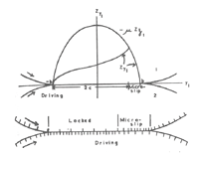Simtex™
Simtex™ paper calendering
Simtex™ offers increased calendering efficiency and low operating costs and is the ideal Supercalender roll for LWC, SC and glassine or Release paper. Because of its high marking and temperature resistance, Simtex™ offers greatly extended grinding intervals. This translates into fewer roll changes, less downtime and increased output. Typically, Simtex™ offers grinding intervals between 1000 and 1500 hours (depending on roll position and running conditions). Long grinding intervals combined with an average grinding depth of 1mm account for the very long lifetime achievable with Simtex™ .
Raw materials
The Simtex™ formulation uses specially selected synthetic fibres, prepared in a unique way. Fibres are oriented circumferentially to coincide with the direction of material to be calendered, giving maximum ‘forged’ strength and smoothness. The circumferential orientation of fibres is combined with the strength of the fibres – 3 times stronger than steel, weight for weight. This gives the Simtex™ cover outstanding dimensional stability, enabling it to keep its shape in the supercalender over extended running periods.
Simtex™ calender rolls are able to withstand 250c+ maximum roll surface temperature.
Fig. 1
Simtex™ calender rolls:
- Boost productivity
- Help avoid bottlenecks in supercalenders
- Give excellent gloss and smoothness properties
- Significantly reduce operating costs
Why use Simtex™
- Regrind interval up to 1500 hours
- No loss in gloss & smoothness compared to a cotton or polymer roll – fully elastic nip.
- Greater depth of material – less risk.
- No special steel shell required – the original bowl shafts can be used.
- Longer life
- Minimal marking
- No effect from edge wear and vibration problems
Finish
Simtex™ creates full friction gloss in the nip, caused by micro-slip, improving the look and feel of the material with increased glaze and smoothness. Polymer rolls are unable to add frictional force or the resultant microslip, so surface finish capability is severely restricted. Both the cast epoxy Polymer rolls and the epoxy-dipped synthetic Composite types suffer from cracking and deformation, leading to short working life despite their high cost. Polymer / composite covers are too rigid to cope with non-uniform conditions at the nip, leading to a high risk of damage caused by debris, folds, edge wear and vibration if the loading is uneven. Relatively small localised pressure variations above 4% can cause failure. Simtex™ , however, is produced from a special combination of high-tech synthetic fibres which give full elasticity, deforming as required to match fluctuating pressures across the nip. Simtex™ has high Niploads and temperature ranges and filled rolls can withstand niploads up to 450 kN / m and steel roll surfaces of 250c+. These extended performance parameters allow a solid security margin in case of surface accidents.
Gloss and smoothness are related to calendering temperatures. Simtex™ offers the possibility of increasing calender temperatures to improve paper surface characteristics. Alternatively, the same existing characteristics of gloss and smoothness can be achieved using less line pressure, hence preserving bulk.
Simtex™ can be re-surfaced on standard equipment such as diamond lathe tool, belt sanding and wet-stone grinding.
Roll Lifetime
Physical Properties of SimtexTM
- Simtex™ operates at a maximum bowl temperature of 250°C+, with a maximum temperature of the steel roll at 400°C+
- Simtex™ has excellent mark resistance – most marks will not show
- Simtex™ can be machined in the same way as cotton rolls with a usable diameter 100mm
- Simtex™ can be wet ground
- Simtex™ can be doctored
Advantages over Composite / Polymer Rolls
Unlike composite / plastic rolls, Simtex™ can be used to upgrade your calender with the advantage of creating full friction gloss in the nip caused by micro-slip.
Finish
- Polymer roll gives surface finish by replication – like a steel roll but very smooth surface. No friction (no micro-slip), so no added heat.
- Polymer rolls are incapable of adding any frictional force to the glossing process
- Simtex™ gives surface finish by Micro-slip friction, resulting in increased glaze/gloss and smoothness – see Fig. 1
Elasticity
Poisson’s ratio is a measure of the relative incompressibility of a cover:
- Steel has a Poisson’s ratio of 0.3 (incompressible)
- Polymer cover: 0.3-0.35 (incompressible)
- Cotton roll 0.17 (much more elastic)
- Simtex™ 0.2 (much more elastic)
Nip Condition
The lack of resistance in a polymer cover will not allow it to comply with ANY non-uniform nip condition. The polymer roll will not deform but will try to support an uneven load. For this reason, polymer covers are much more susceptible to damage from debris / folds going through the nip. Local pressure variations in excess of 4% of the total nip being applied can cause failure.


